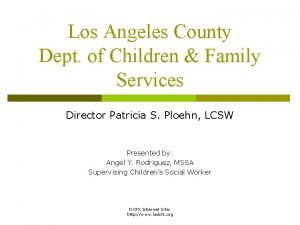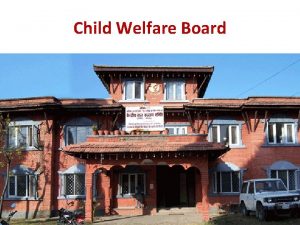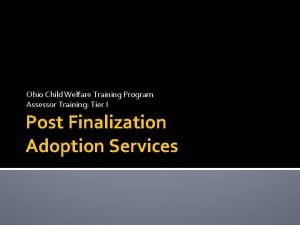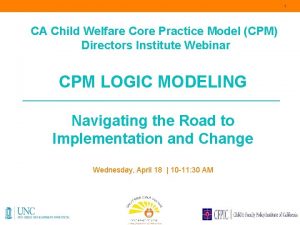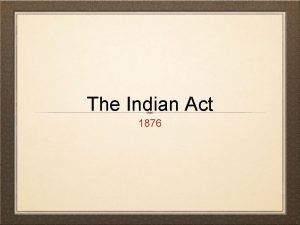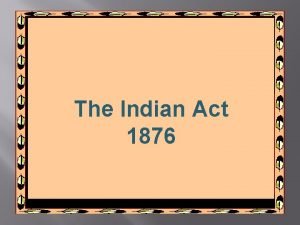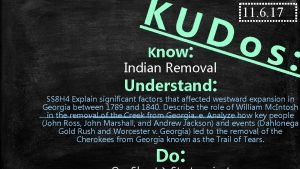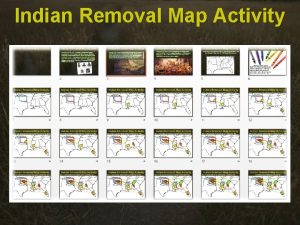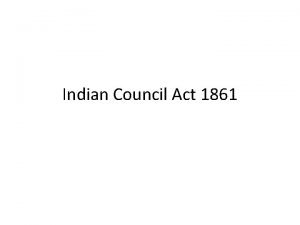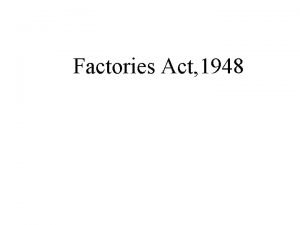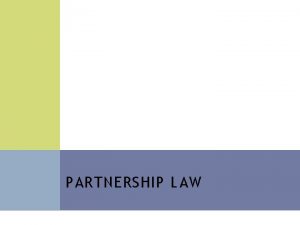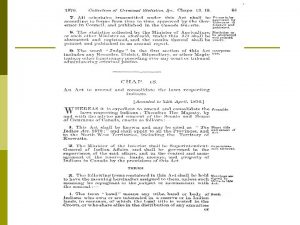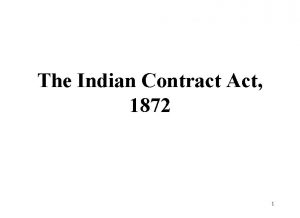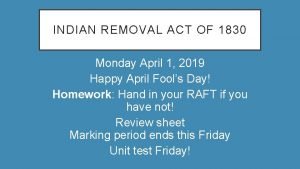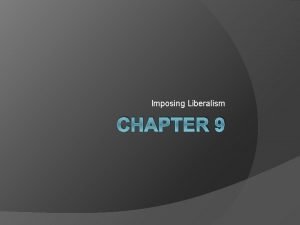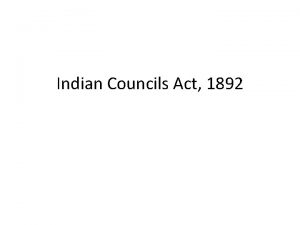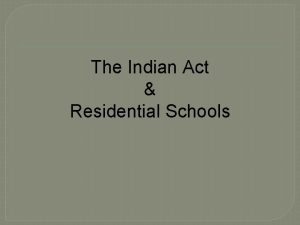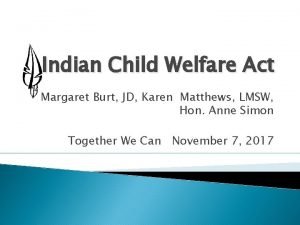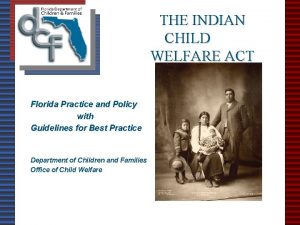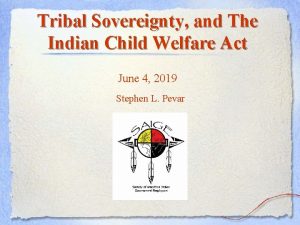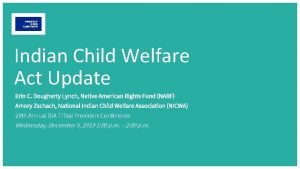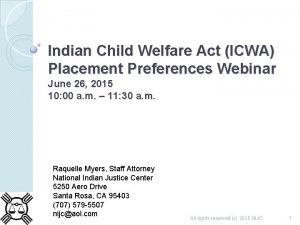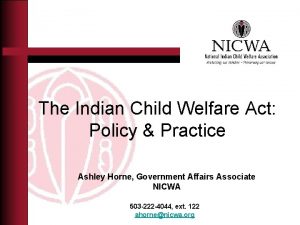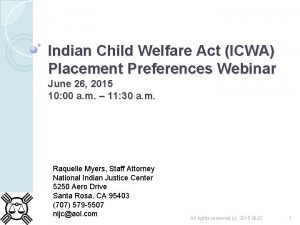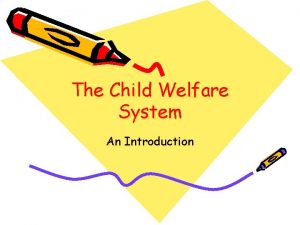The Indian Child Welfare Act Have Child Welfare


































- Slides: 34

The Indian Child Welfare Act: Have Child Welfare Issues Improved in Indian Country? 19 th Annual Multi-Jurisdictional Law Enforcement Conference Green Bay, Wisconsin, Nov. 8, 2007 Presented by: Attorney Paul Stenzel – Stenzel Law Office November 8, 2007

• Part I: History and Purpose of the Indian Child Welfare Act • Part II: Effectiveness of ICWA • Part III: Issues • Part IV: Questions & Discussion

History & Purpose • From the late 19 th century to the mid 1970 s, Indian families were subjected to various forces which negatively impacted the family unit: – Allotment Act – Assimilation – Termination

Carlisle Indian School ca. 1900

History & Purpose By the 1960 s there was a recognition that Indian families were being broken apart at an alarming rate due to state social service departments removing children and placing them in non. Indian homes.

History & Purpose Studies in 1969 and 1974 showed that 25% to 35% of all Indian children had been separated from their families and placed in adoptive families, foster care, or institutions.

History & Purpose The same studies found that in the State of Minnesota one in eight Indian children under the age of 18 was in an adoptive home, and during 1971 -1972 nearly one in every four infants under one year of age was placed for adoption.

History & Purpose In Wisconsin the risk of being separated from their children was 1, 600% greater for Indians.

History & Purpose 90% of the Indian placements were in non. Indian homes.

History & Purpose In South Dakota, 40 percent of all adoptions by the State were of Indian children, yet they made up only 7% of the population.

History & Purpose Congressional hearings demonstrated the tremendous harm that had come to Indian families, tribes and children. The ICWA was passed to prevent it from happening in the future.

History & Purpose “Probably in no area is it more important that tribal sovereignty be respected than in an area as socially and culturally determinative as family relationships. ” Holyfield, 490 U. S. at 34 (quoting, Chief Isaac, hearings in front of the Lands of the House Committee on Interior & Insular Affairs, 95 th Cong. , 2 d Sess. , at 193 (1978)).

History & Purpose • Without ICWA, the best interest of the child standard, as defined by the mainstream culture, fails to take into account Tribes’ unique culture. • The ICWA, by providing for intervention and an order of placement preferences, essentially added new elements to the best interest of the child standard which recognize tribal interests.

History & Purpose ICWA sought to do three things: 1. Keep Indian children with their families. 2. Defer to tribal judgments and decisions about custody of Indian children. 3. If Indian children must be removed from their families, they should be placed with members of their extended family or members of their Tribe.


Effectiveness • The Act is still a positive and needed law. – Issues are with application and compliance. • The Act has improved placement of Indian children with Indian families. • The Act has raised awareness among state social workers.

Effectiveness • South Dakota study: – Lack of consistency in identifying Indian children: In 15% of the records reviewed, no documentation existed of how the court or DSS determined that the child was Indian. – Untimely notice to Tribes 13% of the time. – 45% of the files reviewed did not clearly indicate whether ICWA preferences were being followed.

Effectiveness Alaska • A study in the early 1990 s revealed that in involuntary cases of relinquishment of Indian parental custody where notice to the tribe is required under ICWA, State social workers notified tribes in only 47. 3 percent of cases reviewed. The State notified tribes in only 77. 8 percent of cases prior to termination of parental rights

Effectiveness NEBRASKA STATEWIDE ASSESEMENT: » 68% of records reviewed did not include documentation of steps taken to determine whether the child was an Indian child within the meaning of the Act » Documentation indicating a finding of “clear and convincing evidence” for placement of an Indian child was absent in 78% of case records reviewed » When developing a case plan, P&S Workers did not include the parent/custodian or the use of tribal or community resources in 64% of cases

Effectiveness Nebraska (cont’d) » Cultural conditions and way of life of the child’s tribe or Indian community were considered in only 33% of the case plans reviewed » Workers from most Service Areas do conduct a “diligent search” in order to comply with placement preference which includes contact with the Tribe’s social services program in 54% of cases reviewed Neb. Health & Human Servs. Sys. , Child and Family Servs. Review Statewide Assessment, May 2002, at 1– 113 available at http: //www. hhs. state. ne. us/jus/cfsr/final. pdf.

Effectiveness Minnesota: • 11. 5% of foster care population is American Indian; 1. 6% of general population is American Indian • As a percent of placements of American Indian children, from 2002 through 2005, the average rate of American Indian children in relative foster care was 20. 2 percent. • Statewide rate during the same period was about 16%

Effectiveness Minnesota and Tribes there agreed to definition of active efforts: • “Active Efforts” means active, thorough, careful, and culturally appropriate efforts by the LSSA to fulfill its obligations under ICWA, MIFPA, and the DHS Social Services Manual to prevent placement of an Indian child and at the earliest possible time to return the child to the child's family once placement has occurred. (25 U. S. C § 1912(d)). • Minnesota State/Tribal Agreement on Indian Child Welfare

Effectiveness IOWA state law: Active efforts shall include but are not limited to all of the following: a. A request to the Indian child's tribe to convene traditional and customary support and resolution actions or services. b. Identification and participation of tribally designated representatives at the earliest point. c. Consultation with extended family members to identify family structure and family support services that may be provided by extended family members.

Effectiveness (Iowa Active Efforts (cont’d)) d. Frequent visitation in the Indian child's home and the homes of the child's extended family members. e. Exhaustion of all tribally appropriate family preservation alternatives. f. Identification and provision of information to the child's family concerning community resources that may be able to offer housing, financial, and transportation assistance and actively assisting the family in accessing the community resources. Iowa Code § 232 B. 5(19)

Issues • ICWA does not require notice to Tribes in voluntary proceedings. • ICWA does not require notice to Tribes in adoptions.

Issues • • • Lack Lack of of of (timely) notice to Tribes identification of Indian children Indian foster homes active efforts counsel in CHIPs proceedings

Issues • Adoption and Safe Families Act (ASFA) – “ 15 of 22” requirement; can be an issue when notice not given timely to Tribe. – ASFA requires reunification efforts, but States relieved from that requirement in certain situations; – ASFA does not pre-empt ICWA (In re. J. S. B. , 2005 SD 3, 691 N. W. 2 d 611 (2005)). (Court reject argument that ASFA trumped ICWA active efforts requirement where father had a documented history of abuse and neglect. )

Issues • Existing Indian Family doctrine – Some courts have made exceptions to the application of ICWA by finding that the despite an Indian child’s membership in a tribe, the Act was not intended to apply when a family has no apparent cultural ties to a Tribe. • Trend is moving towards rejection of this unjustified doctrine. • Doctrine was essentially rejected in Holyfield v. Mississippi, 490 U. S. 30 (1989)

Issues • Safe haven for dropping off newborns (e. g. Wis. Stat. 48. 195) – Conflicts with 10 -day requirement under 25 USC 1912(a) – No determination of membership

Issues • There have been efforts to amend the Act to address some of these issues. • The effort in 1996 probably came the closest to enactment. – Controversy arising in private adoptions – The Rost case (In re Bridget R. , 40 Cal. Rprt. 2 d 507 (1996)). – “The hearings … demonstrated that avoidable and prolonged litigation over the application of ICWA needlessly destabilizes some Native American adoptions. ” (House Report 104 -808)

Q&A Ideas for improvement: • Mandatory training for social workers • Better screening tools to ID Indian children at intake • More tribal – state interaction • More education for judges, prosecutors, attorneys and social workers

Q&A • Possible amendments to ICWA: – Clarify EIF doctrine is not allowable – Clarify ASFA does not pre-empt ICWA – Define active efforts – Require notice to tribe in voluntary proceedings and adoptions – Address safe haven laws for dropping off newborns

Q&A • What are the issues in your jurisdiction? • What are your success stories? • What could be done to improve compliance with the ICWA? • What amendments, if any, are needed to ICWA? • What have been your experiences with the Act in different jurisdictions?

Attorney Paul Stenzel PO Box 11696 Shorewood, WI 53211 414 -963 -9923 www. paulstenzel. com
 R a 9344
R a 9344 Act 1 act 2 act 3
Act 1 act 2 act 3 6 square faces 12 edges and 8 vertices
6 square faces 12 edges and 8 vertices National health programme for children in india
National health programme for children in india National policy and legislation related to child health
National policy and legislation related to child health Agencies related to welfare services to the child
Agencies related to welfare services to the child National agencies for child welfare
National agencies for child welfare Child welfare services
Child welfare services Central child welfare board
Central child welfare board Ohio child welfare training program
Ohio child welfare training program Child welfare
Child welfare Vr3 child welfare foundation
Vr3 child welfare foundation Cpm implementation
Cpm implementation Indian act 1876
Indian act 1876 Indian act 1876
Indian act 1876 Indian removal act
Indian removal act Indian factory act
Indian factory act Trail of tears map activity
Trail of tears map activity India council act 1861
India council act 1861 Factories act 1948 objectives
Factories act 1948 objectives Section 26 partnership act 1961
Section 26 partnership act 1961 Indian act summary
Indian act summary Section 2 d consideration
Section 2 d consideration Indian contract act 1872
Indian contract act 1872 Nature of contract
Nature of contract Indian removal act of 1830
Indian removal act of 1830 Indian it act
Indian it act Indian removal act of 1830
Indian removal act of 1830 Imposition of liberalism examples
Imposition of liberalism examples Hình ảnh bộ gõ cơ thể búng tay
Hình ảnh bộ gõ cơ thể búng tay Bổ thể
Bổ thể Tỉ lệ cơ thể trẻ em
Tỉ lệ cơ thể trẻ em Voi kéo gỗ như thế nào
Voi kéo gỗ như thế nào Thang điểm glasgow
Thang điểm glasgow







